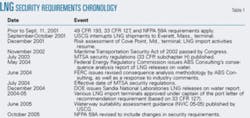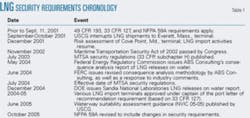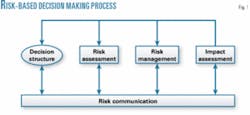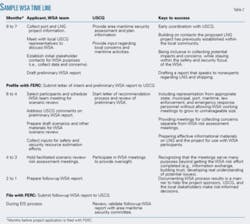Transportation and handling of LNG is not a zero-risk activity because of both potential accidents and intentional events, but new risk-based analysis approaches make risks that cannot be eliminated manageable.
The challenge for industry, local communities, and regulators is to apply appropriate risk-based evaluations to help define where LNG facilities are appropriate and specific design, operational, security, and emergency response measures to reduce potential risks to the public.
The Sept. 11, 2001, terror attacks forced developers to address security risks, both in terms of what regulators believe should be done and what it takes to address valid, local community concerns.
This article outlines current LNG security issues, summarizes recent publications that have affected the LNG security picture, and describes the current process for addressing security risks for US LNG import terminals.
There are clearly risks associated with importing and handling LNG, as there are risks involved with gasoline, propane, ammonia, chlorine, and a host of other fuels and chemicals required for the US economy to function. Siting of LNG facilities has always been difficult.
The Sept. 11 attacks, however, strengthened public opposition to LNG facilities, affecting both the public’s attitude about what can happen and media attention to potential security threats for existing and proposed LNG facilities. This concern has pushed risk-based decision making into an important role in gaining approval of proposed LNG terminals by federal regulators and local communities.
Risks, history
The LNG industry has an excellent safety record spanning more than four decades.1 2 About 40 LNG receiving terminals currently operate worldwide, as well as 17 LNG liquefaction export plants, and more than 240 peak-shaving and LNG storage facilities. LNG releases from any US-based facility have not led to public injury since a 1944 accident at a peak-shaving facility in Cleveland, Ohio, in which 128 died and 225 were injured.
Opponents of LNG have focused on this accident. Industry and regulators, however, have addressed its causes and other potential large-scale releases through strict codes, standards, and regulations. These changes have made such an event less likely, both by reducing the potential for an LNG release (i.e., specification of appropriate materials for construction) and by controlling the spread of any liquid release that might occur (i.e., requirements for secondary containment).
An accidental release of LNG has killed only one worker in the US. That event, in 1979 at the terminal in Cove Point, Md., resulted in code and standard changes to reduce the potential for future events of that type.
There have been worker fatalities overseas at LNG facilities, including the January 2004 event at a liquefaction plant in Skikda, Algeria, which resulted in 27 fatalities and 55 injuries.3 LNG import facilities currently being proposed for US locations, however, would not use the high-pressure steam boilers involved in that accident.
LNG vessels, which have made more than 35,000 ocean voyages covering more than 60 million miles, are among the safest and most reliable cargo fleets in service. Since the industry’s creation in 1959, there have been no reported fatalities or loss of cargo from vessel containment on any LNG ship.
Small LNG releases have occurred from above-deck piping and valves, but none of those events has had serious safety consequences. There have also been ship collisions and groundings, but these have not resulted in cargo releases.
These safety statistics provide reassurance if the only concern is accidental releases, but the public has become increasingly focused on the potential of terrorist attacks seeking to cause a release intentionally. Terrorists, however, in hundreds of attacks during 40 years, have so far not attacked an LNG facility and have only rarely attacked chemical or hydrocarbon facilities.
Many safety analysts believe that a terrorist attack on a facility handling LNG is unlikely to be any more severe (and in fact may be less severe) than catastrophic accidents experienced in US hydrocarbon processing facilities that did not involve LNG (Tosco, Avon, Calif., 1999; IMC, Sterlington, La., 1991; ARCO, Channelview, Tex., 1990; Phillips 66, Pasadena, Tex., 1989; Shell, Norco, La., 1988; Union Oil, Romeoville, Ill., 1984). Although all of these events seriously affected on site workers (as many as 23 fatalities in a single event), there were no fatalities outside the industrial sites where the accidents occurred.
Since a large-scale LNG release would likely either be ignited by the event that caused the release or find an ignition source as it drifted downwind from the point of release, the primary effect of any large LNG release will be an on site fire (for a release from a processing facility) or a fire that burns near the point of release (for a release from an LNG carrier to the water).
Security requirements
The Sept. 11 attacks led to a focus on LNG security. Table 1 outlines many of the security requirements and provides a chronology of changes made.
Historically, there have been security requirements in both codes and standards (National Fire Protection Association NFPA 59A) and regulations applicable to LNG facilities (US Code of Federal Regulations 49 CFR 193 and 33 CFR 127). Immediately after the terrorist attacks, authorities stopped shipments of LNG to the Everett, Mass., terminal while security issues were addressed. LNG carriers going to the Everett terminal pass through Boston Harbor, and concern was voiced about the potential for terrorist attacks. After about a month of analysis and planning, shipments resumed.
In the same time frame (October through December 2001), the US Coast Guard was determining what safety and security measures should be applied to reactivation of LNG imports to the Cove Point, Md., LNG terminal. As part of that effort, the USCG held a risk-assessment workshop based on its risk-based decision making (RBDM) guidelines and involving a wide range of stakeholders.4 5
Fig. 1 outlines the general RBDM process. The process provides a structure that leads a team to define questions that need to be answered to support effective decision making and to follow a process to answer those questions. It also emphasizes the importance of effective risk communication to all stakeholders. The RBDM process has been developed and documented by the USCG, in partnership with ABSG Consulting Inc., during the past decade and is applied to a broad range of safety and security issues.6
The Cove Point risk assessment identified potential safety and security events that could be associated with resuming LNG activities and recommended a set of USCG and terminal safety and security measures that should be instituted. The assessment contributed to both the USCG LNG operational plan for shipments to the terminal and the issuance of a letter of recommendation that the captain of the port issued as part of the Cove Point terminal resuming operation.
Additional studies
Recognizing the need for additional information to support consideration of proposed LNG terminals, the US Federal Energy Regulatory Commission and the Department of Energy each sponsored a study in 2004 that addressed the consequences of LNG releases onto water.
Although the consequence-analysis techniques employed in those studies are equally applicable to accidental events and deliberate attacks, public concerns regarding potential terrorist attacks were clearly part of the incentive to perform these studies. FERC and DOE undertook these studies in part because of the numerous previous studies published by members of the public and industry groups that did not clearly define their inputs, assumptions, and details of their methodology.
ABS Consulting performed the FERC study, which addressed the consequences of an LNG release from an LNG carrier, assuming a hole of a given size penetrating both the double hull and the cargo containment. The initial report was released in May 2004.7 As defined in FERC’s scope of work, the study did not include analysis of how such events could occur or the specific response of a ship to such a release. The effort focused entirely on modeling the vaporization of the LNG, downwind dispersion of an un-ignited cloud, and the potential radiant heat effects of an ignited release.
Based on industry comments and FERC’s plans for use of the methodology, ABS Consulting revised the methodology. FERC issued the revised report in June 2004, along with responses to many of the industry comments that had been received8 and is using it in assessing potential events involving proposed LNG terminals (in conjunction with the analyses required by 49 CFR 193 for onshore LNG equipment).
Sandia National Laboratories performed the DOE-sponsored study, issuing a report in December 2004.9 10 The Sandia report focused entirely on LNG releases on water, but its scope included evaluating both accidental and deliberate events that could damage an LNG carrier and result in an LNG release. It also made recommendations regarding appropriate ways to model such releases.
What Sandia included that was not part of any earlier effort was a recommendation of potential hazard zones (expressed as distances from the point of an LNG release on the water) that represent high, medium, and low levels of consequence to members of the public. For intentionally initiated events (which are projected to result in larger LNG releases than accidents), these zones are 500, 1,600, and 3,500 m, respectively.
Sandia also noted that more detailed, site-specific modeling is appropriate in some cases. The Sandia report suggested that security measures, for both prevention and mitigation purposes, could be prioritized based on what levels of population fall within each of these zones.
Terminal approval
From 2002 through 2005, FERC approved 10 onshore LNG terminal expansions or new LNG terminals. In second-half 2004, FERC began implementing the methodology approaches from the consequence study it sponsored. FERC has also revised its regulations to require LNG terminal applicants to prefile a notice of their intention to file for LNG terminal approval.11
Additionally, the Sandia study affected the review role of the USCG in support of FERC licensing of LNG terminals. Based on 33 CFR 127, all new terminals require issuance of a letter of recommendation from the USCG before the terminal goes into operation. In providing the LORs issued to date, the USCG has implemented various security-assessment approaches based on the RBDM guidelines, Maritime Transportation Security Act regulation guidance, what was done for previous terminals, and local community inputs.
Based on the lessons learned in those activities, USCG headquarters developed guidance for an analysis it has termed Waterway Suitability Assessment.12 A Navigation and Vessel Inspection Circular (NVIC 05-05) issued on June 14, 2005, provides this guidance.13 14
The NVIC mandates that a preliminary WSA report be provided to the USCG when the applicant submits its prefiling documentation to FERC. That document provides information regarding the port and the project and must outline how the applicant is going to perform the safety and security risk assessments required of the marine activity associated with the project. The applicant must then document a completed WSA in what the USCG calls the “Follow-on WSA Report.” The accompanying box on p. 58 outlines the required contents of a WSA report.
The cornerstone of the WSA is the risk, threat, and vulnerability analysis that it requires. That analysis, which is sponsored by the proposed terminal’s proponents, must involve qualified facilitators, USCG representatives, and local stakeholders (e.g., law enforcement and emergency response personnel) and is similar to the security assessments required under the USCG MTSA regulations.
The WSA process requires the team to postulate accident scenarios (e.g., groundings, ship collisions) and intentional acts of violence (e.g., boat bomb attacks, standoff weapon attacks) along the course of the LNG carrier transit. The team then examines the consequences of those attacks, using the hazard zones defined in the Sandia report. The team then defines mitigation based on its assessment of the likelihood of those events in the specific port environment and the consequences for effects on the public and critical infrastructure.
This structured approach allows development of security measures that are specific to the LNG project, port, and local community. The team also has to estimate potential resources required for safety and security measures recommended and identify how those resources can be provided.
Table 2 outlines an example time line for performing a WSA. It indicates tasks that the applicant and the USCG perform and provides some keys to orchestrating a successful WSA.
References
- Foss, Michelle, “LNG Safety and Security,” University of Texas Center for Energy Economics, October 2003.
- “Safety History of International LNG Operations,” CH IV International, June 2002.
- Kornfield, Sally, et al., “Report of the US Government Team Site Inspection of the Sonatrach Skikda LNG Plant in Skikda, Algeria, March 12-16, 2004,” April 2004.
- Dweck, Jacob and Sparling, Steven, “Steering Discussion,” Hazardous Cargo Bulletin, March 2004.
- “US Coast Guard Risk-Based Decision Making Guidelines,” 2001 (http://www.uscg.mil/hq/g-m/risk/e-guidelines/rbdm.htm) (developed with support from ABS Consulting).
- Walker, David et. al., “Applying Risk-based Decision-making Methods/Tools to Transportation and Facility Security Risk Management,” 17th Annual International Conference and Workshop: Risk, Reliability, and Security, Center for Chemical Process Safety, Jacksonville, Fla., Oct. 8-11, 2002.
- “Consequence Assessment Methods for Incidents Involving Releases from Liquefied Natural Gas Carriers,” Report 131-04, ABSG Consulting Inc., May 4, 2004.
- “Consequence Assessment Methods for Incidents Involving Releases from Liquefied Natural Gas Carriers,” Federal Emergency Regulatory Commission Notice of Availability, ABSG Consulting Inc., June 18, 2004.
- Hightower, Mike, et al., “Guidance on Risk Analysis and Safety Implications of a Large Liquefied Natural Gas (LNG) Spill Over Water,” SAND2004-6258, Sandia National Laboratories, December 2004.
- Dweck, J., Sparling, S., and Wochner, D., “Sandia LNG study changes landscape for terminal siting,” Oil and Gas Journal’s LNG Observer, April-June 2005, p. 10.
- “Regulations Implementing Energy Policy Act of 2005; Pre-Filing Procedures for Review of LNG Terminals and Other Natural Gas Facilities,” Federal Register, Oct. 18, 2005.
- Testimony of Captain David L. Scott on the Coast Guard’s Role in LNG Safety and Security before the Committee on Energy and Natural Resources, Subcommittee on Energy, US Senate, Feb. 15, 2005.
- “Navigation and Vessel Inspection Circular Guidance on Assessing the Suitability of a Waterway for Marine Traffic (NVIC 05-05),” US Coast Guard, June 2005.
- Meyer, E.A., Weimer, D., and Sparling, S., “US Coast Guard redefines LNG terminal permitting process,” Oil & Gas Journal’s LNG Observer, January-March 2006, p. 10.
The author
Myron L. Casada (mcasada @absconsulting.com) is vice-president-marine, offshore, ports and terminals at ABSG Consulting Inc., Houston. He has 30 years’ experience in system reliability and risk assessment, having worked in process safety, risk management, and risk assessment for JBF Associates, Inc., which is now part of ABS Consulting. Casada is a registered professional engineer in Tennessee and holds a BS in nuclear engineering and an MS in engineering administration (with a concentration in system reliability and risk assessment) from the University of Tennessee at Knoxville. He is a member of NSPE, AIChE, and NFPA.
WSA report contents, per NVIC 05-05Port characterization
This section of the WSA report summarizes information about the port to address the needs and interests of decision makers and of interested and affected parties. It evaluates the impact of LNG operations on the entire port community, primarily to assess the resource requirements needed to provide a safe and secure environment for the proposed LNG operations. It generally includes graphics that show the footprint of the LNG operation in the port and identifies populated areas, critical infrastructure, and key assets.
Characterization of the LNG facility and LNG tanker route
This section of the WSA report provides details for the proposed LNG facility waterfront configuration and physical construction. It also describes the proposed LNG tanker characteristics, frequency of deliveries, and other carrier operation specifics (use of escort tugs, pilot services, maneuvers required to berth the vessel) and their potential impacts on other traffic in the waterway.
The WSA uses zones of concern as described in the NVIC. The zones are based on the hazard zones defined in the Sandia study for intentional events. Geographic information system technology helps provide the WSA team with graphics that display port characterization information and the outer perimeter of the zones along the entire transit in order to depict:
- What port and community features fall within those zones.
- Where the population density meets high and medium population criteria (which are defined as 9,000 persons/sq mile or greater and 1,000 to 9,000 persons/sq mile, respectively).
- Critical infrastructure and key assets.
- Important structures (e.g., industrial, commercial, residential, city centers, military installations, schools, hospitals, cultural centers).
- Sensitive environmental areas.
The report also must detail the density and character of marine traffic along each segment of the waterway, including commercial, military, and recreational vessels.
Risk, threat, and vulnerability analyses
In this step, the WSA team analyzes the risks associated with the introduction of LNG operations into the port. The analysis is to identify and understand the individual risks so that appropriate risk-management strategies can be developed.
The USCG recommends that an applicant use a generally accepted risk-based decision making methodology that is as objective and transparent as possible. The risk-assessment portion of the WSA looks at the situations that could result in a release of LNG, both accidental (collisions, groundings, spills, etc.) or intentional (terrorist act, sabotage, etc.).
Risk-management strategies
Using the guidance provided in the NVIC as a starting point, the WSA team identifies potential risk-management strategies for the various scenarios identified and determines which risk-management strategies are appropriate.
Resource needs for safety, security, and response
The WSA effort concludes by identifying the resources needed to implement the selected risk-management measures, what new resources are needed, and where those resources might be obtained.





